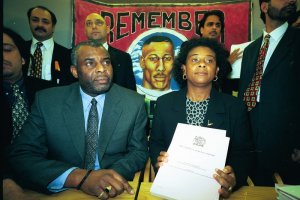For years, racism has been defined by the violence of far-right extremists, but a more insidious kind of prejudice can be found where many least expect it – at the heart of respectable society
Tuesday 30 May 2017 05.30 BST (Last modified on Wednesday 31 May 2017 17.04 BST)
WN: The piece highlighted below is riveting and powerful. It complements another brilliant piece, “White Fragility“. Two women of different colour give witness to a reality horribly rampant, devastating and entrenched in our world. And yes: in our world of respectability, religious or secular, it is invariably present – and ubiquitously throughout human history as well.
excerpts:
On 22 February 2014, I published a post on my blog. I titled it “Why I’m No Longer Talking to White People about Race”. It read: “I’m no longer engaging with white people on the topic of race. Not all white people, just the vast majority who refuse to accept the existence of structural racism and its symptoms. I can no longer engage with the gulf of an emotional disconnect that white people display when a person of colour articulates their experience. You can see their eyes shut down and harden. It’s like treacle is poured into their ears, blocking up their ear canals. It’s like they can no longer hear us.“This emotional disconnect is the conclusion of living a life oblivious to the fact that their skin colour is the norm and all others deviate from it.
“At best, white people have been taught not to mention that people of colour are “different” in case it offends us. They truly believe that the experiences of their life as a result of their skin colour can and should be universal. I just can’t engage with the bewilderment and the defensiveness as they try to grapple with the fact that not everyone experiences the world in the way that they do.
“They’ve never had to think about what it means, in power terms, to be white, so any time they’re vaguely reminded of this fact, they interpret it as an affront. Their eyes glaze over in boredom or widen in indignation. Their mouths start twitching as they get defensive. Their throats open up as they try to interrupt, itching to talk over you but not to really listen, because they need to let you know that you’ve got it wrong.
“The journey towards understanding structural racism still requires people of colour to prioritise white feelings. Even if they can hear you, they’re not really listening. It’s like something happens to the words as they leave our mouths and reach their ears. The words hit a barrier of denial and they don’t get any further.
“That’s the emotional disconnect. It’s not really surprising, because they’ve never known what it means to embrace a person of colour as a true equal, with thoughts and feelings that are as valid as their own. Watching [the documentary] The Color of Fear by Lee Mun Wah, I saw people of colour break down in tears as they struggled to convince a defiant white man that his words were enforcing and perpetuating a white racist standard on them. All the while he stared obliviously, completely confused by this pain, at best trivialising it, at worst ridiculing it.
“I’ve written before about this white denial being the ubiquitous politics of race that operates on its inherent invisibility. So I can’t talk to white people about race any more because of the consequent denials, awkward cartwheels and mental acrobatics that they display when this is brought to their attention. Who really wants to be alerted to a structural system that benefits them at the expense of others?
“I can no longer have this conversation, because we’re often coming at it from completely different places. I can’t have a conversation with them about the details of a problem if they don’t even recognise that the problem exists. Worse still is the white person who might be willing to entertain the possibility of said racism, but who thinks we enter this conversation as equals. We don’t.
“Not to mention that entering into conversation with defiant white people is a frankly dangerous task for me. As the hackles rise and the defiance grows, I have to tread incredibly carefully, because if I express frustration, anger or exasperation at their refusal to understand, they will tap into their presubscribed racist tropes about angry black people who are a threat to them and their safety. It’s very likely that they’ll then paint me as a bully or an abuser. It’s also likely that their white friends will rally round them, rewrite history and make lies the truth. Trying to engage with them and navigate their racism is not worth that.
“Amid every conversation about Nice White People feeling silenced by conversations about race, there is a sort of ironic and glaring lack of understanding or empathy for those of us who have been visibly marked out as different for our entire lives, and live the consequences. It’s truly a lifetime of self-censorship that people of colour have to live. The options are: speak your truth and face the reprisals, or bite your tongue and get ahead in life. It must be a strange life, always having permission to speak and feeling indignant when you’re finally asked to listen. It stems from white people’s never-questioned entitlement, I suppose.
“I cannot continue to emotionally exhaust myself trying to get this message across, while also toeing a very precarious line that tries not to implicate any one white person in their role of perpetuating structural racism, lest they character-assassinate me.
“So I’m no longer talking to white people about race. I don’t have a huge amount of power to change the way the world works, but I can set boundaries. I can halt the entitlement they feel towards me and I’ll start that by stopping the conversation. The balance is too far swung in their favour. Their intent is often not to listen or learn, but to exert their power, to prove me wrong, to emotionally drain me, and to rebalance the status quo. I’m not talking to white people about race unless I absolutely have to. If there’s something like a media or conference appearance that means that someone might hear what I’m saying and feel less alone, then I’ll participate. But I’m no longer dealing with people who don’t want to hear it, wish to ridicule it and, frankly, don’t deserve it.”
After I pressed publish, the blogpost took on a life of its own. Years later, I still meet new people, in different countries and different situations, who tell me that they have read it. In 2014, as the post was being linked to all over the internet, I braced myself for the usual slew of racist comments. But the response was so markedly different that it surprised me.
…
Neville and Doreen Lawrence at the press conference following the 1999 Macpherson inquiry report into their son Stephen Lawrence’s murder. Photograph: Sean Smith for the GuardianThe Macpherson report was published in February 1999. It concluded that the investigation into the death of Stephen Lawrence “was marred by a combination of professional incompetence, institutional racism and a failure of leadership by senior officers”. This institutional racism, the report explained, is “the collective failure of an organisation to provide an appropriate and professional service to people because of their colour, culture, or ethnic origin. It can be seen or detected in processes, attitudes and behaviour which amount to discrimination through unwitting prejudice, ignorance, thoughtlessness and racist stereotyping which disadvantage minority ethnic people.”
Most importantly, the report described institutional racism as a form of collective behaviour, a workplace culture supported by a structural status quo, and a consensus often excused and ignored by authorities. Among its many recommendations, the report suggested that the police force boost its black representation, and that all officers be trained in racism awareness and cultural diversity.
Kent police’s deputy chief constable Bob Ayling spoke to the BBC’s Newsnight programme that month, calling the Met’s original investigation into Lawrence’s death “seriously flawed”. Another key witness had come forward, Ayling revealed, but his testimony had been dismissed. Three phone calls had been made to the police by a woman who was believed to be close to one of the suspects, but her statements were not adequately followed up.
A review of forensic evidence eventually led to a new trial of those suspected of murdering Stephen Lawrence. On 4 January 2012, 19 years after Lawrence’s death, two out of the five suspected men were finally found guilty and sentenced for his murder. When Gary Dobson and David Norris killed Lawrence, they were teenagers. By the time they were jailed, they were adult men, in their mid- to late 30s. While Stephen Lawrence’s life ended at 18, theirs had continued, unhindered, in part aided by the police.
Both men received life sentences. When passing the sentence, Mr Justice Treacy described the crime as a “murder which scarred the conscience of the nation”. It was a monumental day for Britain, and long overdue. Many were left wondering how the police had failed so catastrophically, and why justice took so long to come.
…
In the same year I decided to no longer talk to white people about race, the British social attitudes survey recorded a significant increase in the number of people who were happy to admit their own racism. The sharpest rise, according to a Guardian report, was among “white, professional men between the ages of 35 and 64, highly educated and earning a lot of money”.
This is what structural racism looks like. It is not just about personal prejudice, but the collective effects of bias. It is the kind of racism that has the power to drastically affect people’s life chances. These highly educated, high-earning white men are very likely to be in positions that influence others’ lives – teaching, prosecuting, examining college applicants and hiring staff. They are almost certainly the kind of people who set workplace cultures.
They are unlikely to boast about their politics with colleagues or acquaintances because of the social stigma attached to holding racist views. Their racism is covert. It doesn’t reveal itself in spitting at strangers in the street. Instead, it lies in an apologetic smile while telling a non-white employee that they didn’t get the promotion. It manifests itself in a CV tossed in the bin because the applicant has a foreign-sounding name. Racism is woven into the fabric of our world. This demands a collective redefinition of what it means to be racist and what we must do to end it.
…
In 2015, a London School of Economics report called for gender quotas in all senior public and private positions. When a survey in the same year showed that less than 20% of senior managers in the City of London were female, women in the financial sector began calling for quotas to tackle the problem. Similarly, in a 2013 survey, more than half of women working in construction – many of whom were employed by companies in which women accounted for just 10% of the workforce – supported the idea of quotas.
But when it comes to race, the language is much less definitive. Instead of quotas – the progress of which can be easily statistically measured – the solutions posed are vague. In 2015, the head of Ofsted suggested that a programme of positive discrimination be applied to teaching recruitment, stressing that the ethnic mix of teachers in a given school should reflect that of its pupils. When he was head of the Greater Manchester police, Sir Peter Fahy called for a change in equality legislation so that police constabularies could use positive discrimination when hiring black police officers – he was sure to let it be known that it wasn’t about “targets”. The problem is that when there are no hard targets for programmes of positive discrimination, they will always run the risk of looking like they’re doing something without achieving much at all.
Positive discrimination initiatives are often vehemently opposed. Whenever I am invited to speak in panel discussions about race and representation, issues of meritocracy and quotas tend to be high on the audiences’ agenda. The main questions asked are: do quotas mean that women and people of colour are receiving special treatment denied to others, and shouldn’t we just judge candidates on merit alone? The prevailing view is that majority-white leaders in any industry have got there through sheer hard work alone.
At the core of such opposition is the belief that positive discrimination just isn’t fair – that whiteness isn’t, in and of itself, a leg-up in the world. But, if it isn’t, how do you explain the glut of middle-aged white men clogging the upper echelons of most professions? We do not live in a meritocracy, and to pretend that simple hard work is enough to elevate everyone to success is an exercise in wilful ignorance.
Opposing positive discrimination based on the fear of not getting the right people for the right jobs inadvertently reveals what you think talent looks like, the kind of person you think it resides within. If the current system worked correctly and hiring practices were genuinely successful, our workplaces would appear very different from how they do now.
There was once a time when even I thought that efforts to increase black representation were suspicious. I didn’t understand why there was a need for them. I could never understand why, when I was growing up, my mum told me to work twice as hard as my white counterparts. As far as I was concerned, we were all the same. When she forwarded me an application form for a diversity scheme at a national newspaper while I was at university, I felt angry, indignant and ashamed. At first I resisted applying for it at all. I felt that if I was going to compete with my white peers, I wanted to do it on a level playing field. After some cajoling on her part, though, I applied, got through to the interview stage, and eventually landed the internship.
At the time, internship schemes looking for black and minority ethnic participants seemed unfair to me, but once I got through the door, I realised why they were necessary: any black people I saw were far more likely to be doing the catering or cleaning than setting the news agenda.
…
My blackness has been politicised against my will, because racism has given it meaning. This is a situation I didn’t choose, but I don’t want it wilfully ignored in an effort to instil some sort of precarious, false harmony. And, though many are happy to console themselves with a doctrine of colour-blindness, the huge differences in life chances between white and non-white people prove that while it may be preached by our institutions, it is not being practised.
Reni Eddo-Lodge
“There are people who consider themselves left, progressive and very critical, who have convinced themselves that the only way to get beyond race is to stop talking about race. By taking this stance, they align themselves with the post-racial liberals and self-styled colour-blind conservatives.”
Colour-blindness is a childish, stunted analysis of racism. It starts and ends at “discriminating against a person because of the colour of their skin is bad”, without any accounting for the ways structural power works in these exchanges. This definition of racism is often used to silence people of colour when we attempt to articulate the racism we face. When we point this out, we are accused of being racist against white people, and the avoidance of accountability continues.
The reality is that, in material terms, we are nowhere near equal. This state of play is violently unjust. The difference that people of colour are all vaguely aware of from childhood is not benign. It is fraught with racism, racist stereotyping and, for women, racialised misogyny.
It is nigh-on impossible for children of colour to educate ourselves out of racist stereotyping, though if we accumulate enough individual wealth, we can pretend that we are no longer affected by it.
Not seeing race does little to dismantle racist structures or improve the lives of people of colour. In order to do so, we must see race. We must see who benefits from their race, who is affected by negative stereotyping of theirs, and on whom power and privilege is bestowed – not just because of their race, but also their class and gender. Seeing race is essential to changing the system.
Main image by Ben the Illustrator
This is an edited extract from Why I’m No Longer Talking to White People about Race by Reni Eddo-Lodge, published by Bloomsbury Circus on 1 June.
• Follow the Long Read on Twitter at @gdnlongread, or sign up to the long read weekly email here.
Please click on: Whites and Racism



